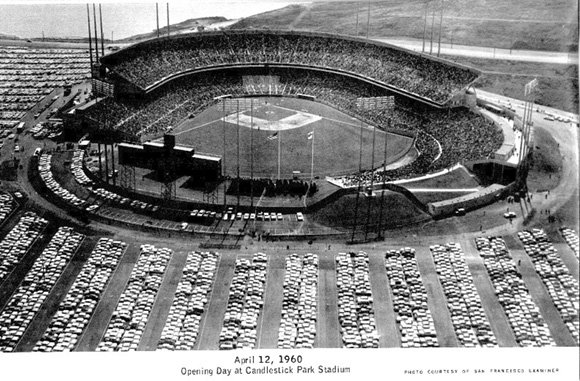
Barring an unlikely series of events, tonight marks the final game at Candlestick Park, built for the San Francisco Giants and now home of the NFL’s 49ers. Jesse Goldberg-Strassler looks back at the historic venue.
The New York Giants won the World Series in 1954, drawing over one million fans to the Polo Grounds. Two short years later, with Willie Mays still starring in the outfield, they ranked last in the National League in attendance. The Polo Grounds, unlike Mays, was showing its age. And persuasive Walter O’Malley, owner of the Brooklyn Dodgers, was whispering in the ear of Giants boss Horace Stoneham.
It may not be remembered now, but baseball was not healthy in the 1950s, leading to a series of relocations: The Boston Braves left for the far more welcoming partisans in Milwaukee. The St. Louis Browns (after Bill Veeck’s forced sale of the team) were delivered to Baltimore investors with open arms. The Philadelphia Athletics skedaddled for Kansas City. All three teams found much greater success and profits; none of these moves made the waves of the Dodgers’ and Giants’ West Coast departure following the 1957 season.
Credit the canny O’Malley for making a deal with the rising golden boomtown of Los Angeles, moving directly into the L.A. Coliseum, and turning the image of the Brooklyn Bums into Hollywood idols. The Giants and Stoneham, who had earlier flirted with a move to Minneapolis and even purchased land in suburban St. Louis Park, did not a similar deal in place. Their new home was no coliseum: It was the old bailiwick of the minor-league San Francisco Seals.
A new stadium was arranged to be erected on the only free lot in the city, located down at Candlestick Point. Yes, wind might be an issue… but architect John Bolles had configured the upper tier to prevent the weather from affecting the game too much.
We pause now to allow you a hearty laugh.
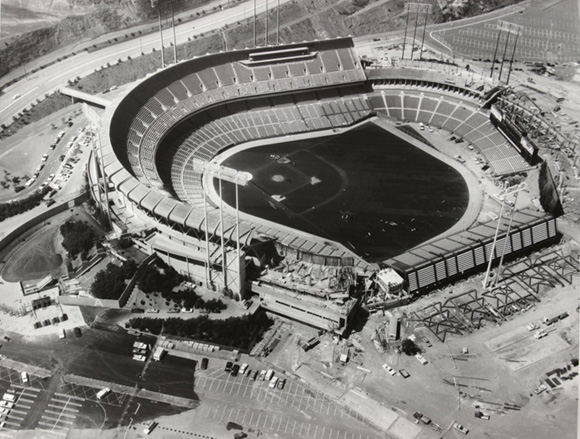
Candlestick Park under construction.
The $15-million Candlestick Park, built solely from reinforced concrete, opened on April 12th, 1960, pitting the Cardinals against the Giants. In the April 13th, 1960, edition of the Oakland Tribune, Ray Haywood’s article (titled “Wind Turns Fans Really True-Blue”) notes, “House beautiful and house cold. Although Candlestick Park undoubtedly is the Taj Mahal of baseball — a beautiful, commodious creation in steel and concrete — it might not be a fit place either for shirtsleeves or right-handed hitters aiming for the left-field fence.”
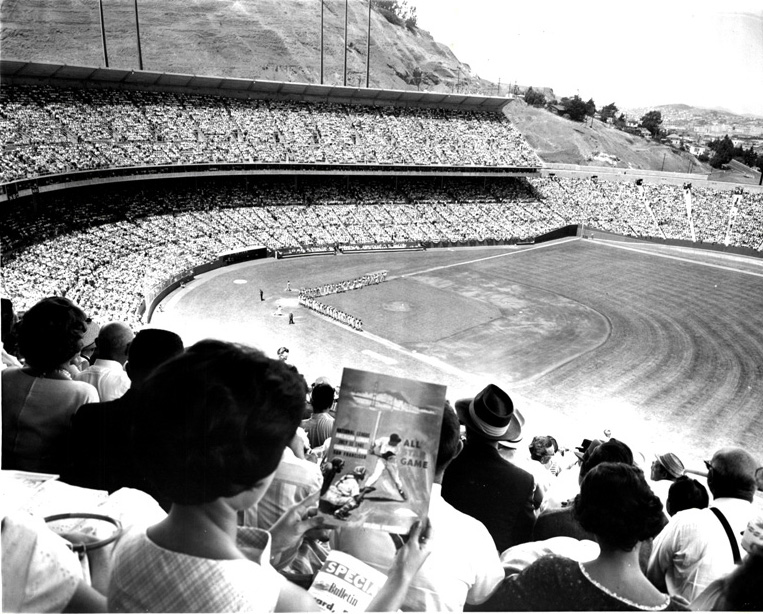
The 1961 All-Star Game at Candlestick Park.
This was mere understatement. By 1961, when the facility hosted the first of two Major League All-Star Games, the UPI noted, “American League players… declared that Candlestick Park’s tricky winds were strictly for the seagulls.” This followed in the wake of one of the wind’s more famous moments, when 165-pound Giants pitcher Stu Miller came on in relief in the top of the ninth inning and was reportedly blown off the mound by a 60-mph gust of wind. (Decades later, Miller says he wasn’t blown off the mound, but admits the wind affected his delivery, leading to a balk.) There may never be a more understandable (or cartoonish) balk in the game’s history,
But this is also part of Candlestick Park’s charm. San Francisco is not Los Angeles, and the Stick is not Dodger Stadium. The field, wrote ESPN.com’s Bill Williamson, was nicknamed The Quagmire. The park, Bruce Nash and Allan Zullo related in The Baseball Hall of Shame, has been nicknamed “The Abomination by the Bay” and “Baseball’s Alcatraz.” The Giants eventually embraced the hostile natural atmosphere, presenting the “Croix de Candlestick” to fans who endured the frigidly inhumane entirety of extra-inning ordeals.
Tonight, after hosting the San Francisco 49ers’ Monday Night Football tilt against Atlanta, Candlestick Park closes its doors for the last time, barring an unlikely series of events that could see the 49ers hosting a playoff game. During its 54 seasons of hosting professional baseball and football, it has served as the antithesis of the scripted Los Angeles experience. Fans have not attended The Stick to look and be looked at; they attended for the spectacle of sport, withstanding sun, wind, cold, and even a calamitous earthquake to bear witness to some of the greatest athletes and moments that baseball and football have to offer.
In 1962, baseball’s oral tradition tells us that the San Francisco grounds crew soaked the baselines to help gain an advantage against Dodgers record-breaking base-thief Maury Wills. A dramatic playoff-series victory against LA catapulted the Giants into the World Series against their old rivals, the Yankees. A classic seven-game World Series ended heartstoppingly at the Stick, with Willie McCovey’s potential game-winning laser of a line drive sticking in the glove of New York second baseman Bobby Richardson. Three seasons in, and the park already boasted one of the most dramatic moments in the history of the Fall Classic.
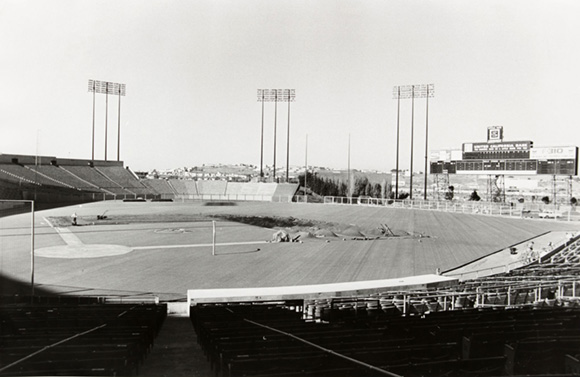
Artificial turf installed at Candlestick Park.
From drama to trauma, with aggravated assault for good measure: On August 22, 1965, Giants ace Juan Marichal shocked those in attendance, clubbing Dodger catcher John Roseboro in the head with his baseball bat. From the UPI, “When it was all over, Marichal was chased from the game and Roseboro had a two-inch cut on the top of his head.” (“I was worried about Roseboro — I thought he lost an eye. But it was just blood in the eye,” Dodger skipper Walt Alston told the AP’s Mike Rathet.) Willie Mays was the game’s true standout, earning plaudits from both sides for rescuing the bleeding Dodger (a good friend of his) from the fray, and then belting a three-run homer to give the Giants the overshadowed win.
Mays reached greater heights on May 4, 1966, eclipsing the National League home run record (though it would not stay his for long). On July 3, a magnificent single-game hitting performance was turned in, but not by Mays or McCovey. Instead, it was the Braves’ Tony Cloninger, who clobbered two grand slams and drove in nine runs — all while pitching a complete game in a 17-3 Atlanta victory. Speaking of greatest hits: nearly two months later, on August 29, the stadium hosted the Beatles’ final concert.
There were no hits to be found on September 17, 1968, when Gaylord Perry twirled the Giants’ first no-hitter at Candlestick Park in a 1-0 win against the Cardinals. Weirdly, St. Louis’s Ray Washburn returned the favor the next day, holding San Francisco without a hit in a 2-0 Cards triumph. (The only other Giants no-hitter in Candlestick history came on August 24, 1975, thanks to the immortal Ed Halicki.)
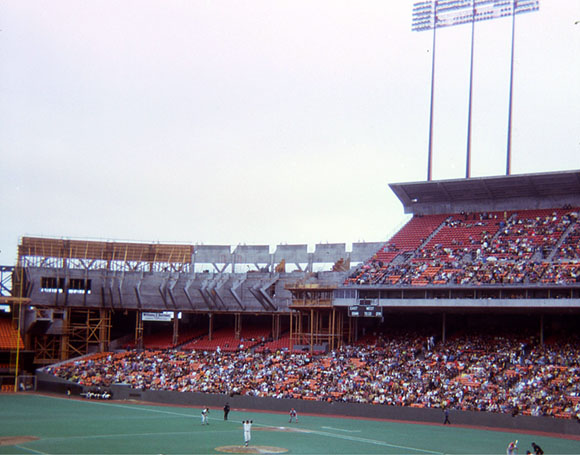
The expansion of Candlestick Park for the arrival of football.
On July 18, 1971, the great Willie Mays notched his 3,000th career hit, witnessed at Candlestick Park. Several months later, the park welcomed in new residents: the National Football League’s San Francisco 49ers, reigning NFC West champions. (It should be noted, just as a point of a trivial interest, that the stadium’s very first football team was the AFL’s Oakland Raiders, who played 10 games at the Stick in 1960 and 1961.) In accordance with hosting the 49ers regularly, the facility was renovated to enclose the seating area. No longer did the wind rush in and out at top speed; now it merely was kept inside, swirling wickedly. While the Giants’ fortunes went cold, failing to reach the World Series from 1963-1988, the 49ers were a powerhouse that brought playoff contests to Candlestick Park, capturing the NFC West title in 1971, ’72, 1981, ’83, ’84, ’85, ’86, ’87, ’88, ’89, ’90, ’92, ’93, ’94, ’95, ’97, ’02, ’11, and ’12.
“The Catch” in baseball refers to Willie Mays tracking down Vic Wertz’s colossal drive in the 1954 World Series, but football’s own version took place at the Stick in the NFC Championship Game on January 10, 1982, with Joe Montana finding a leaping Dwight Clark in the back of the end zone with 51 seconds left. The touchdown launched the 49ers into their first Super Bowl. They took advantage, holding off the Cincinnati Bengals, 26-21, for the first of now five titles.
The Giants did not achieve anywhere near the same amount of success, their history dragged down with the likes of Johnny LeMaster.
On September 14, 1986, however, a uniquely redemptive performance uplifted the hardy crowd of 8,594 at the Stick. Normally a catcher, Bob Brenly began the day batting sixth in the lineup and playing third base. In the fourth inning, he tied a Major League record with four errors — two of them on the same play — to gift the Atlanta Braves a 4-0 lead. Damage done, he set about building a comeback. A homer in the fifth brought the Giants within three. A two-run single in the seventh tied the score. In the ninth, batting with two outs and the bases empty, he delivered a 7-6 victory with a solo homer to left. “This man,” said his manager, Roger Craig, “deserves Comeback Player of the Year for this game alone.” (Check out this video of his game accomplishments.)
The Giants recaptured their old glory and brought October baseball back to Candlestick Park at last in 1989. It could not have come at a more frighteningly coincidental time.
Will Clark and National League MVP Kevin Mitchell powered the ball club into a first-ever all-Bay Area series against the Oakland Athletics. After Oakland won the first two games at home, 5-0 and 5-1, the Giants welcomed the A’s to Candlestick for Game 3 on October 17. A half-hour before first pitch, with ABC’s pregame show setting the scene, the 6.9-magnitude Loma Prieta earthquake struck. Sixty-three people died, thousands were injured, and a section of the Bay Bridge collapsed. Ten days passed before the World Series was able to resume. The Giants were summarily swept, but the outcome was now secondary.
Baseball departed Candlestick in 1999, with the boys in black and orange moving into beautiful Pacific Bell Park (now called AT&T Park) on April 11, 2000, almost 40 years to the day of the Stick’s grand opening. Once baseball-only, now Candlestick Park became football-only, dedicating itself to the 49ers.
The park’s tenure now ends. Its final hosting duty is its 36th Monday Night Football appearance, a mark that tops all other stadiums. It will then be imploded, and perhaps turned into an arena and/or a shopping complex.
Candlestick’s legacy is unlike any other. Years from now, tales of fanhood at the Stick may well resemble tales of manhood — nostalgic depictions of how cold it would get, how fierce the wind would whistle, how tough it was to withstand a game, and how it was all worth it to see Mays, Marichal, McCovey, Orlando Cepeda, Montana, Rice, Ronnie Lott, Steve Young, Roger Craig the manager, Roger Craig the running back, Barry Bonds, and Will the Thrill.
Jesse Goldberg-Strassler is the Voice of the Lansing Lugnuts and the author of The Baseball Thesaurus from August Publications.
—-
Share your news with the baseball community. Send it to us at editors@augustpublications.com.
Are you a subscriber to the weekly Ballpark Digest newsletter? You can sign up for a free subscription at the Newsletter Signup Page.
Join Ballpark Digest on Facebook and on Twitter!
Follow Ballpark Digest on Google + and add us to your circles!
